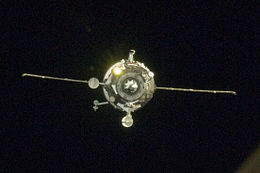Progress M-17M

Progress M-17M approaches the aft docking port of the Zvezda Module.
|
|
| Mission type | ISS resupply |
|---|---|
| Operator | Roskosmos |
| COSPAR ID | 2012-060A |
| SATCAT no. | 38975 |
| Spacecraft properties | |
| Spacecraft type | Progress-M 11F615A60 |
| Manufacturer | RKK Energia |
| Start of mission | |
| Launch date | 31 October 2012, 07:41:19 UTC |
| Rocket | Soyuz-U |
| Launch site | Baikonur Site 1/5 |
| End of mission | |
| Disposal | Deorbited |
| Decay date | 21 April 2013, 15:02 UTC |
| Orbital parameters | |
| Reference system | Geocentric |
| Regime | Low Earth |
| Inclination | 51.6 degrees |
| Docking with ISS | |
| Docking port | Zvezda |
| Docking date | 31 October 2012, 13:33 UTC |
| Undocking date | 15 April 2013, 12:02 UTC |
| Time docked | 165 days, 22 hours, 29 minutes |
| Cargo | |
| Fuel | 683 kg (1,506 lb) |
| Gaseous | 47 kg (104 lb) |
| Water | 420 kg (930 lb) |
|
Progress ISS Resupply
|
|
Progress M-17M (Russian: Прогресс М-17М), identified by NASA as Progress 49 or 49P, was a Progress spacecraft used by Roskosmos to resupply the International Space Station during 2012. The seventeenth Progress-M 11F615A60 spacecraft to launch, it had the serial number 417 and was built by RKK Energia. It was the 130th launch to the ISS and the twentieth Russian space launch in 2012. It was also the eleventh mission for the R-7 family of rockets since the beginning of the year.
On April 15, 2013, Progress M-17M cargo shop undocked from the Space Station. It was disposed six days later and fell into the Pacific Ocean on April 21.
The spacecraft was launched on time at 07:41:19 UTC on 31 October 2012 from Site 1/5 of the Baikonur Cosmodrome in Kazakhstan, atop a Soyuz-U carrier rocket. It was successfully deployed into low Earth orbit ten minutes later. At the time of launch, the ISS was about 1,550 kilometres (963 mi) ahead of the launch site. At the time of orbital insertion Progress was 3,610 kilometres (2,243 mi) behind the ISS.
Like the previous mission, Progress M-16M, Progress M-17M used a fast approach profile to the ISS, rendezvousing and docking on its fourth orbit, as opposed to docking about 50 hours after launch on most previous Progress flights. This profile allowed the transportation of critical biological payloads to the ISS. Following testing on Progress flights, the same rendezvous profile was introduced for manned Soyuz flights in 2013 to reduce crew fatigue.
During the rendezvous sequence, the spacecraft performed several burns and rendezvous impulses to enter the proximity of the International Space Station. The KURS system on board the ISS as well as the Progress was activated for navigational purposes. The TV System was activated at a range of 8 kilometres (5.0 mi) as Progress M-17M continued its approach. Aboard the International Space Station, cosmonaut Yuri Malenchenko was standing by at the TORU system as Progress further came close to Space Station to assume manual control over the spacecraft if an issue with the automated docking was to be spotted. The other two cosmonauts Oleg Novitskiy and Evgeny Tarelkin of Expedition 33 members were assisting Malenchenko and acquired engineering footage of the Progress spacecraft.
...
Wikipedia
